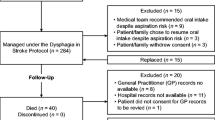Abstract
Aspiration due to dysphagia is a factor associated with pneumonia during acute stroke. In such cases, it is likely that secretions in the pyriform sinuses enter the laryngeal inlet. The present study was based on the idea that it is possible to reduce aspiration pneumonia by periodically suctioning and removing such secretions (pyriform sinus suctioning), a study was conducted in a single facility. The incidence of pneumonia as a dependent variable was compared between before (control) and after (intervention group) intervention with pyriform sinus suctioning as an independent variable. With a view of unifying the quality and frequency of intervention, two programs to: initially confirm the safety of such suctioning; subsequently enhance/evaluate knowledge and skills related to the procedure (educational); and specify conditions for the implementation and criteria for determining its appropriateness (practical), were developed. The study involved 33 (mean age: 74.6 ± 12.4) and 30 (80.0 ± 8.8) control and intervention group members, respectively, 25 (83.3%) of the latter were treated with pyriform sinus suctioning for 5 days after a stroke. Pneumonia developed in 7 (21.2%) and 2 (6.7%) of the former and latter, respectively. As individuals with a Japan Coma Scale (JCS) score of III or a midline shift on head CT tend to develop pharyngeal dysphagia, the patients were also divided into 2 groups to compare the incidence of pneumonia based on the risk level: low: Japan Coma Scale scores of I-II without a midline shift on head CT; and high: scores of II-III with it. In the latter, the incidence after intervention was markedly lower (p = 0.06, φ = 0.326), while the former did not show changes (p = 0.574, φ = 0.066), supporting the effectiveness of pyriform sinus suctioning to prevent aspiration pneumonia among patients with a low risk level.

Similar content being viewed by others
References
Hilker R, Poetter C, Findeisen N, Sobesky J, Jacobs A, Neveling M, Heiss WD. Nosocomial pneumonia after acute stroke: implications for neurosurgical intensive care medicine. Stroke. 2003;34(4):975–81.
Brogan E, Langdon C, Brookes K, Budgeon C, Blacker D. Dysphagia and factors associated with respiratory infections in the first week post stroke. Neuroepidemiology. 2014;43(2):140–4.
Teramoto S. Novel preventive and therapeutic strategy for post-stroke pneumonia. Expert Rev Neurother. 2009;9(8):1187–200.
Aslanyan S, Weir CJ, Diener HC, Kaste M, Lees KR. Pneumonia and urinary tract infection after acute ischaemic stroke: a tertiary analysis of the GAIN International trial. Eur J Neurol. 2004;11(1):49–53.
Dziewas R, Ritter M, Schilling M, Konrad C, Oelenberg S, Nabavi DG, Stögbauer F, Ringelstein EB, Lüdemann P. Pneumonia in acute stroke patients fed by nasogastric tube. J Neurol Neurosurg Psychiatry. 2004;75(6):852–6.
Smithard DG, O’Neill PA, England RE, Park CL, Wyatt R, Martin DF, Morris J. The Natural history of dysphagia following a stroke. Dysphagia. 1997;12(4):188–93.
Mann G, Hankey GJ, Cameron D. Swallowing function after stroke: prognosis and prognostic factor at 6 months. Stroke. 1999;30(4):744–8.
Gordon C, Hewer RL, Wade TD. Dysphagia in acute stroke. Br Med J. 1987;295(6595):411–4.
Paciaroni M, Mazzotta G, Corea F, Caso V, Venti M, Milia P, Silvestrelli G, Palmerini F, Parnetti L, Gallai V. Dysphagia following stroke. Eur Neurol. 2004;51(3):162–7.
Lawrence ES, Coshall C, Dundas R, Stewart J, Rudd AG, Howard R, Wolfe CD. Estimates of the prevalence of acute stroke impairments and disability in a multiethnic population. Stroke. 2001;32(6):1279–84.
Sørensen RT, Rasmussen RS, Overgaard K, Lerche A, Johansen AM. Lindhardt. Dysphagia screening and intensified oral hygiene reduce pneumonia after stroke. J Neurosci Nurs. 2013;45(3):139–46.
Palazzo P, Brooks A, James D, Moore R, Alexandrov AV, Alexandrov AW. Risk of pneumonia associated with zero-degree head positioning in acute ischemic stroke patients treated with intravenous tissue plasminogen activator. Brain Behav. 2016;6(2):e00425.
Eisenhuber E, Schima W, Schober E, Pokieser P, Stadler A, Scharitzer M, Oschatz E. Videofluoroscopic assessment of patients with dysphagia: pharyngeal retention is a predictive factor for aspiration. AJR Am J Roentgenol. 2002;178(2):393–8.
Belafsky PC, Mehdizadeh OB, Ledgerwood L, Kuhn M. Evaluation of hypopharyngeal suction to eliminate aspiration: the Retro-Esophageal Suction (REScue) catheter. Dysphagia. 2015;30(1):74–9.
Engeseihaisikkankenkyuukai. Diagnosis and treatment for aspiration pulmonary disease. Phizer Inc. 2003, Japan.
Sellars C, Bowie L, Bagg J, Sweeney MP, Miller H, Tilston J, Langhorne P, Stott DJ. Risk factors for chest infection in acute stroke: a prospective cohort study. Stroke. 2007;38(8):2284–91.
Acknowledgements
This work was supported by a grant-in-aid from The “YAMAJI FUMIKO NURSING RESEARCH FUND”.
Author information
Authors and Affiliations
Corresponding author
Ethics declarations
Conflict of interest
The authors have no conflicts of interest to declare.
Rights and permissions
About this article
Cite this article
Inui, Y., Kamakura, Y., Fukada, J. et al. Development of Pyriform Sinus Suctioning Programs for Aspiration Pneumonia Prevention During the Acute Stroke. Dysphagia 32, 767–776 (2017). https://doi.org/10.1007/s00455-017-9821-3
Received:
Accepted:
Published:
Issue Date:
DOI: https://doi.org/10.1007/s00455-017-9821-3




